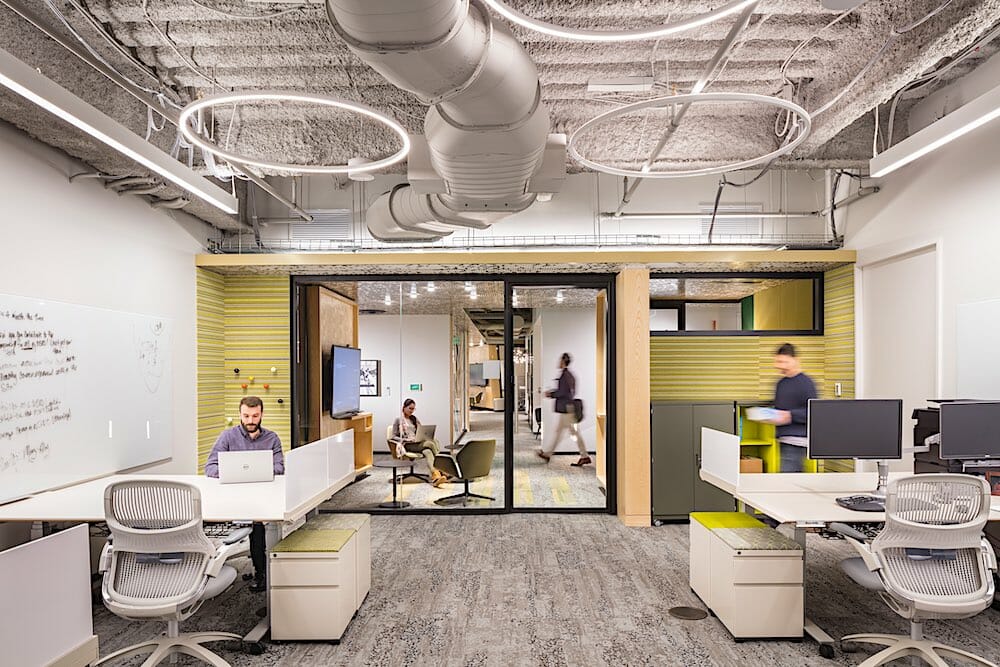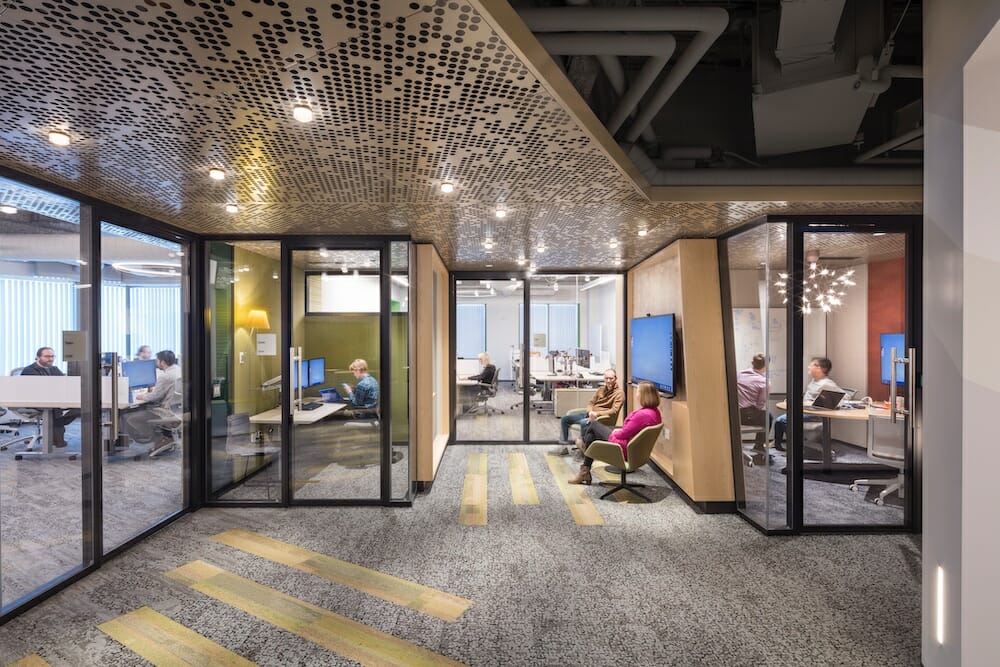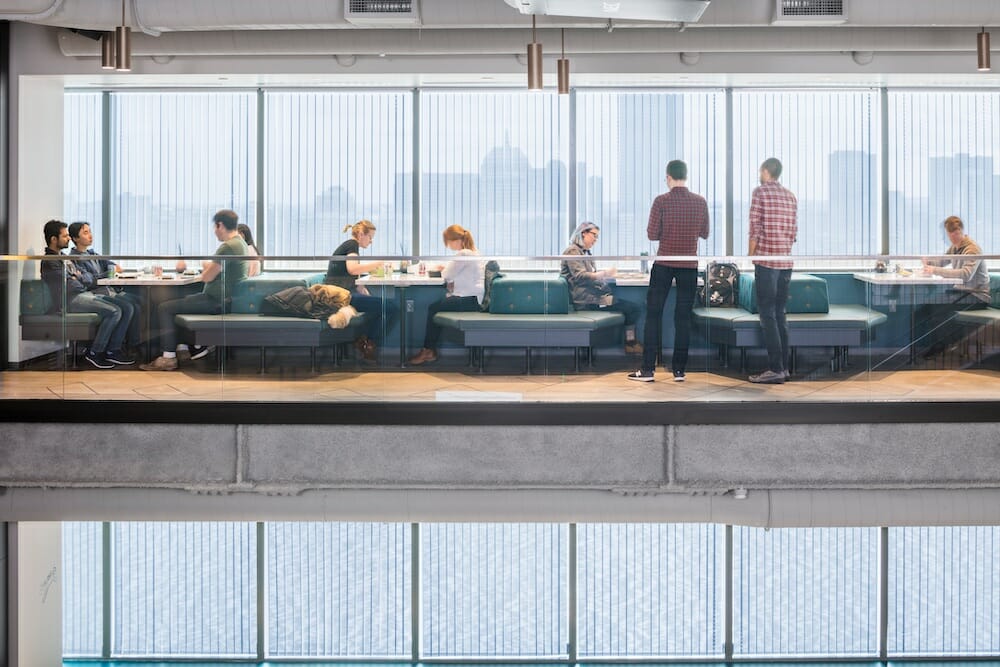What’s the best technology in today’s workplace? Design.
There’s a common thread circulating in the mainstream media today warning of the perils of open office – the lack of privacy, the increase in distraction, the tightness of space.

Virtual reality rooms give Microsoft employees and the public the chance to navigate other universes while keeping both feet on the ground.
By Meredith McCarthy, Sasaki; Photos by John Horner
The New York Times even wrote a satirical piece describing where a person should go to cry in an open office environment (spoiler alert: their recommendation is the restroom). Comedy aside, this growing criticism is tainting the idea of a real estate strategy that is both efficient for space, and vital for innovation.
You’ll find no argument from us that a completely open office is indeed bad for business. A sea of workstations will never inspire big thinking. However, there is something to be said about removing some walls. Breaking down barriers, sitting amongst your colleagues, hearing the evolution of a conversation turning into an idea, and then joining that discussion to help move that idea forward, are all benefits of an open office environment. What’s missing from all those “open-office-is-hell” concepts is the closed office; the spaces where those conversations can go to be loud and boisterous and passionate, without being disruptive. Instead, what’s being included in those concepts is the promise of “technology” at every turn, lauded as the silver bullet to innovation and collaboration.
Often times, when we say technology, we’re referring to some kind of electronics – audio-visual capabilities, fast Wi-Fi, VPN for remote workers, and touch-screen monitors, laptops, and handheld devices. All of these things are presented as vital lifelines to our productivity and our creativity, but they are not the answer to our questions. They are simply a vehicle for the human brain to push and test ideas faster, to separate the successes from the failures in less time, and to help us move forward with only our best thoughts. And if we’re unable to generate that initial concept to spring us from the starting line, no amount of electronic technology is ever going to help us reach the finish. So, then, what is the best technology in the workplace? Design.

Microsoft’s team rooms house 15-20 employees and are filled with whiteboards and moveable furniture to ensure teams have everything they need to succeed in an open office setting
Design As Technology
Nowhere in the definition of technology is there any mention of a computer, or a screen, or a device. It is simply stating that applying knowledge to a situation, practically, is what we use to advance our ideas in our specific industries. As designers, we know there are numerous forms of technology being used throughout businesses, with varying levels of success. We’ve seen the desks that move up and down based on our sitting or standing preferences. We use the cameras in all our devices to encourage more face to face interaction, even if we’re thousands of miles apart. And we do our work along the invisible networks that allow us to connect to a home base no matter where we are in the world.
However, we also know the quickest way to get an idea out of your head is to say it aloud or write it down, and that the most interactions in an office happen in the kitchen. We are well aware that collaboration is a great tool for starting ideas, but focused work is really where those ideas grow wings and soar. So, when we talk about technology, we should look no further than the practical application of a designer’s expertise of how space impacts interactions in order to truly understand what it means to be innovative.

Immediately adjacent to the team rooms are open and enclosed collaboration rooms, allowing innovation to continue.
Let’s take the Microsoft New England Research & Development (NERD) Center in Cambridge as an example. Microsoft is known as a technology company. They are at the cutting edge of their field, making major strides in computer science that impact all of our lives on a daily basis. But they’re trying to move beyond that image of flashy technology and into a world filled with creativity and exploration. That’s hard to do when you’re in a workplace with only private offices. The company needed that ignition, a little spark that starts the flame that turns into a burning inferno of innovation, and they found it in a new workplace without a single private office. There were, of course, concerns with going from an enclosed office to an open workstation. But the gains of eliminating those four walls far outweighed the losses.
The new NERD Center design brings all the individual workspaces to the perimeter of the floor plate and encloses them in team work rooms that hold a maximum of 15 to 20 people; they’re large enough to house project teams, but small enough to contain noise and eliminate distraction. These work rooms are divided by moveable walls to allow small groups occupying one room to expand into an adjacent room if their project team needs to grow. The fancy technology in all of these work rooms? Simple desks on casters that allow teams to reconfigure their spaces however they see fit, and whiteboards on those moveable walls to encourage brainstorming and problem solving in real time. By creating rooms large enough to support a project team, those employees can be assured that the conversations they overhear on a daily basis are absolutely relevant to their every day work. More importantly, they’re also guaranteed not to be distracted by other teams and their discussions or work styles. In this model, the open office has become the open team room, where noise is controlled yet productive.
There are times when noise becomes a detractor from the focused environment of any room. Two people having a discussion at a desk is manageable, but more than that can become a commotion that often rises in volume proportional to the rise in passion and excitement around the idea being discussed. However, that excitement is exactly what a team should want to sustain as they add minds to the evolution of an idea that will soon become a solution. Enter, the collaboration ribbon.

Open seating along Boston’s skyline allow employees to step away from their desks for a change of scenery and a change of perspective.

Social spaces like this two story café bring employees together around food and fun, encouraging them to exchange ideas in a more relaxed and informal setting.
Immediately adjacent to the team rooms, separated by acoustic, soundproof glass, is a zone of collaborative space, which weaves its way around the team rooms, housing different work styles to support many kinds of teams and individual tasks. Open tables and a variety of seating types at the entrance to each team room allow people to seamlessly move evolving conversations outside without the need for a reservation, which can extinguish even the strongest of sparks. Large digital monitors in each space bring the content from the desk to the wall, while white boards support the need to get thoughts written down for everyone to see in the fastest way possible – brain to hand. In addition, larger enclosed rooms provide space for more regular or scheduled ideation sessions with the capacity to link in remote workers via phone and video. Finally, small focus booths sprinkled throughout the area provide secluded work stations where employees can spend a few hours can hunkering down and hammering out a solution.
All of these spaces are filled with state-of- the-art devices – this is Microsoft, after all. But those devices are not what’s fueling this fire. They are tools. The arrangement of space to foster an environment that will support creative work is the true piece of technology in this office space. The application of design knowledge in a practical manner to bolster Microsoft’s innovation is their key to success. So, how are they unlocking their potential? By using design to empower their employees.
Design As Power
The shift from 100% private offices to all team rooms with workstations not only pushed the interaction between colleagues at Microsoft, but it reduced the square footage needed for desks, opening up more space for communal programs that they never had before.
Throughout multiple floors in the Cambridge office, Microsoft now has small nooks and crannies for quiet work and large open gathering spaces for team functions and social events. Banquettes along windows overlooking the Charles River and the Boston skyline give employees the option to move away from their desk for a few hours and enjoy a fresh perspective, mentally and physically. Game rooms with pool tables and ping pong, spaces for meditation and yoga, and a massive Scrabble board on the wall in their main living room all provide places where people can come together to build relationships and cultivate a culture of learning, exploring, and inventing.
Remember that fact from earlier about people having most of their social interactions in the kitchen? Microsoft put that to the test with a double height atrium connecting each of their adjoining floors where people can step away from the intensity of their assignments, grab a coffee or a smoothie, and blow off some steam over a few volleys across the ping pong table, all while easing tension and building rapport, and providing the opportunity for members of different teams to share ideas and create solutions together.
The programming of intentional interaction is creating a mixing pot of minds among the Microsoft employees that is helping the company stay at the forefront of its industry. This opportunity of variety and choice is empowering them to put forward their best work. Again, the idea of practically applying knowledge, in this case, how ideas develop from human interactions, and how the ability to choose a work environment impacts a person’s feeling of power and control, are all paramount to Microsoft’s success. The design of space needs the support of a culture to make it truly shine. And the NERD Center is winning that game over and over again.

The Garage is Microsoft’s space to welcome the public into their office, holding hackathons, internships, and fun events themed around today’s cutting edge technological breakthroughs.
In addition to making room for all that collaborative and social space, the move away from private offices opened the doors for Microsoft to create The Garage, an interactive lab that welcomes employees, partners and outsiders into Microsoft to learn and play and experiment with all things technology.
Virtual reality rooms allow people to immerse themselves in a different world, maker spaces invite people to return to their childhood curiosities of creating and building and inventing, and reconfigurable multipurpose rooms create space for large groups to come together or hold hackathons to talk about current trends and even try to solve some of the world’s most pressing issues. All of this employs various forms of technology, from VR headsets and green screens to 3d printers and laser cutters. And the best part? This amenity is available 24/7 for all Microsoft NERD employees. Writer’s block on that one particular piece of code? Head downstairs and 3d print a bust of your principal design researcher. (It’s real. It happened. There’s proof on Instagram.) Feeling like your workspace needs some flair? Pop into The Garage and design a button to decorate your desk.
Microsoft not only provided the space to be creative, but they are celebrating it across their office, encouraging people to step away from work and flex their minds in a completely different way. This isn’t simply an “if you build it, they will come” situation. The NERD Center hasn’t only built the space – they’ve provided a road map, and that is chauffeuring their employees to a destination. That effort is launching them into the stratosphere of innovation.
Design As The Silver Bullet
Maybe there’s no such thing as a silver bullet to success, but we feel strongly that design gets you most of the way there. Organizing space to capitalize on the ways in which natural human behavior leads to ingenuity is the best first step in transforming a business. Providing employees with the power of choice in how and when they want to work allows for comfort, which pushes productivity, taking that first step and turning it into a giant leap. Add to that a culture and an environment that encourages people to bring their full selves to work, and you’re sprinting toward the front lines of making major progress in your industry.
We spend hours at a time interacting with technology, much of which is wasted down the rabbit hole that swiping and double-tapping has created. Let’s reclaim that time spent in isolation and replace it with personal interaction, rethink what it means to be in a workplace with limitless information at our fingertips, and tap into the boundless creativity in the mind of the person sitting next to us. Let’s invest in applying the knowledge of human behavior to the creation of space so that we are not only moving forward as individuals on a path of discovery and innovation, but are growing together as a community, strengthening our bonds with one another and collectively making the world a better place. Design is that knowledge. Let’s use it to make the best workplaces possible.
